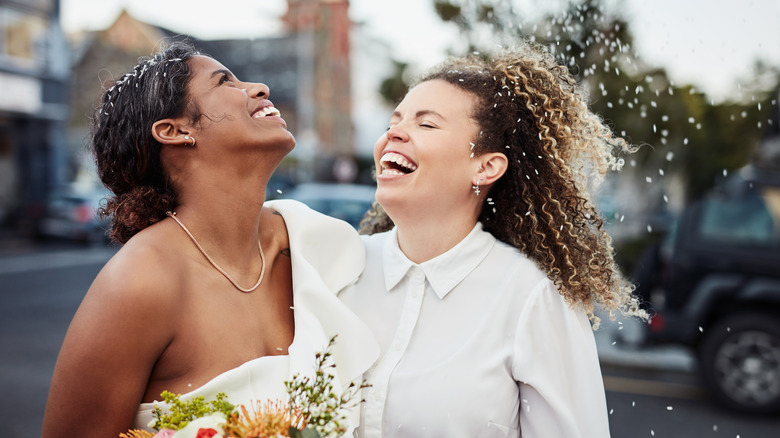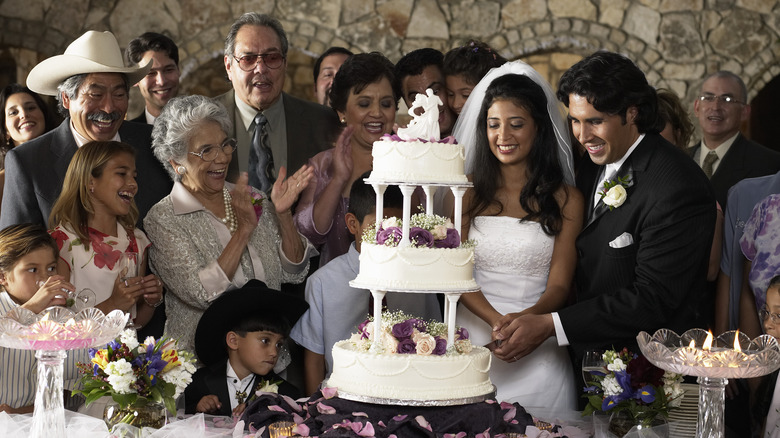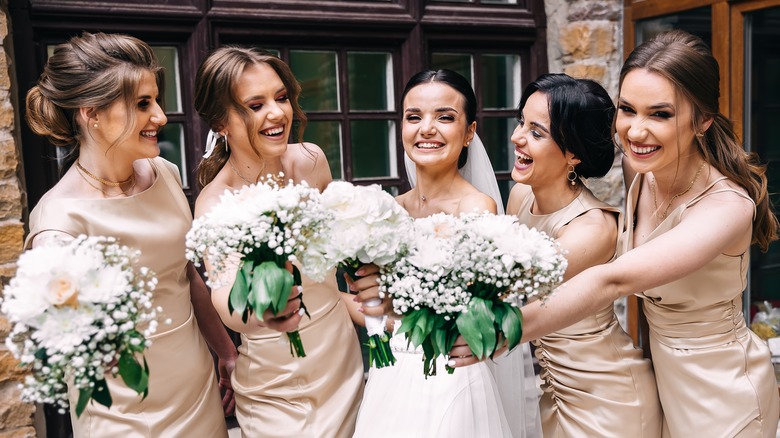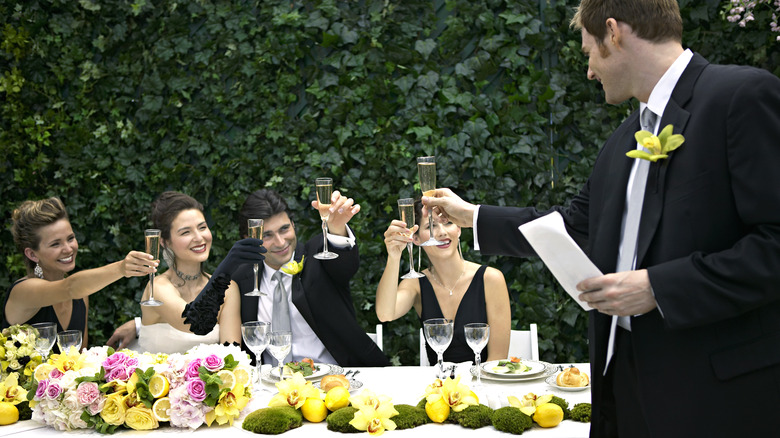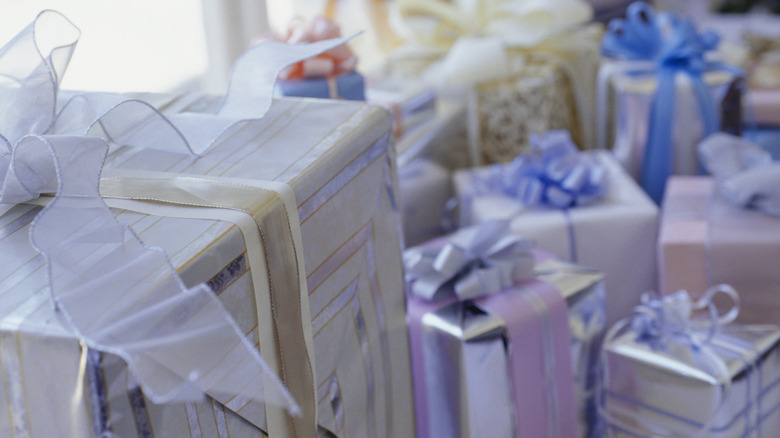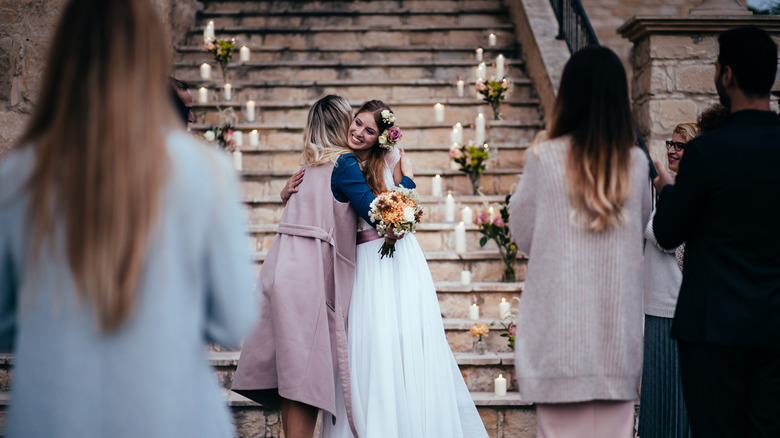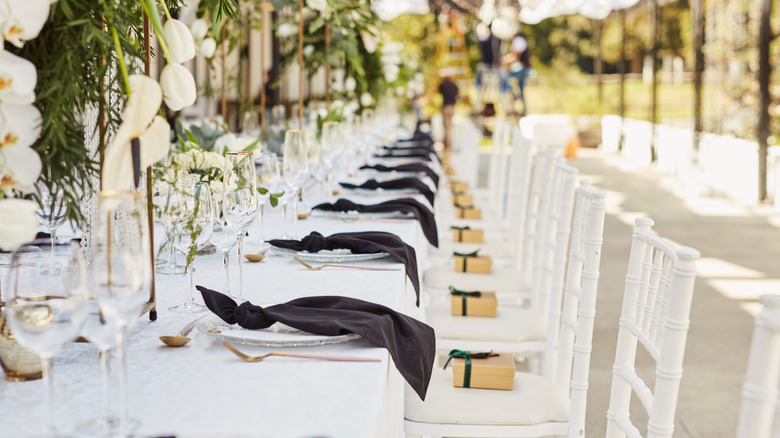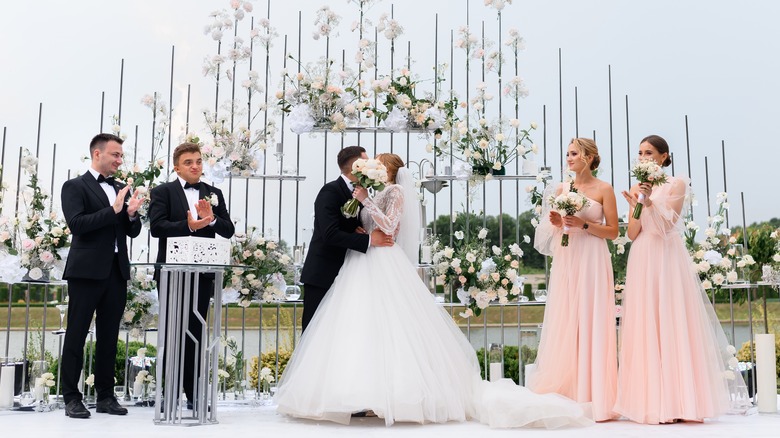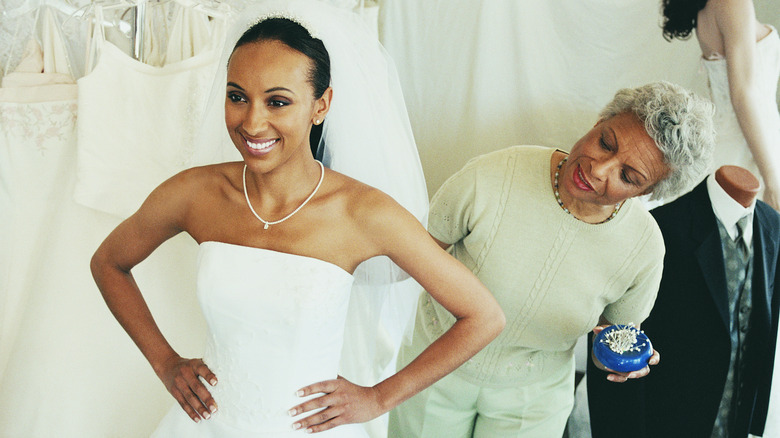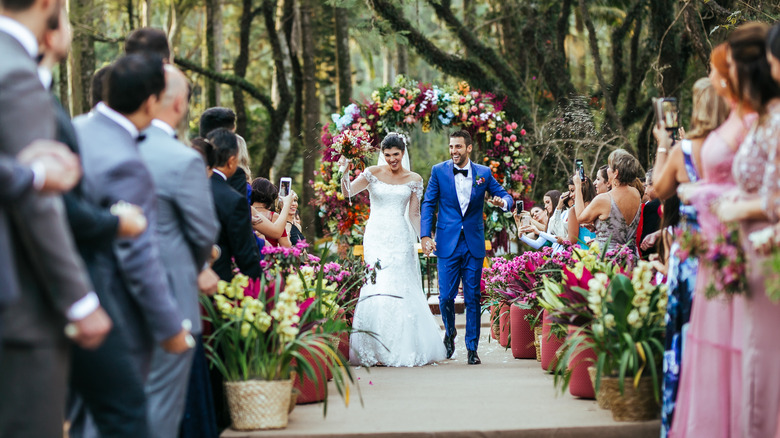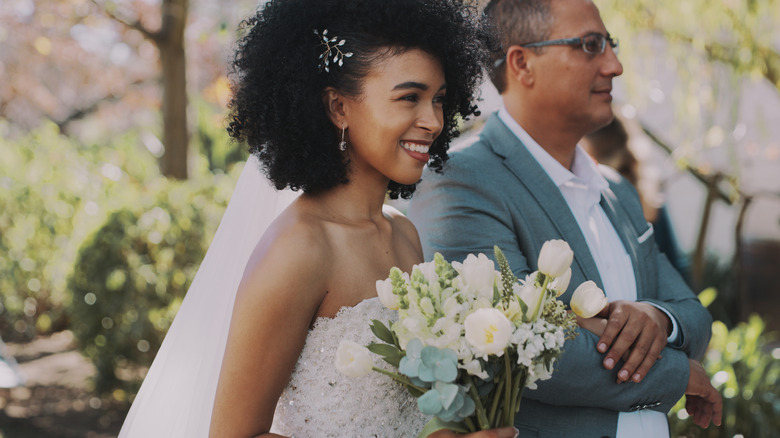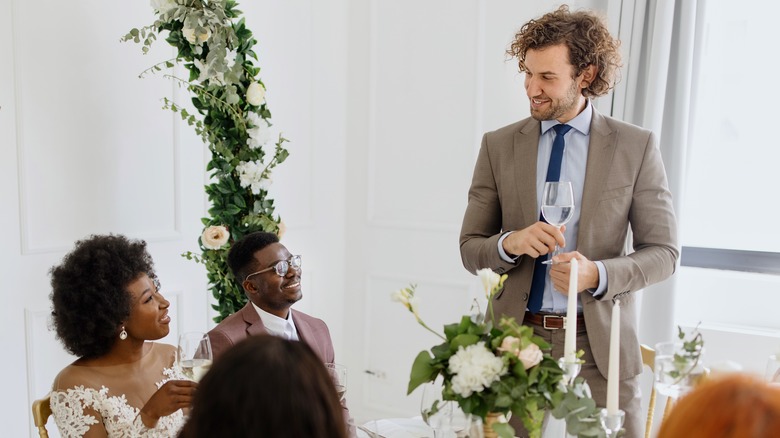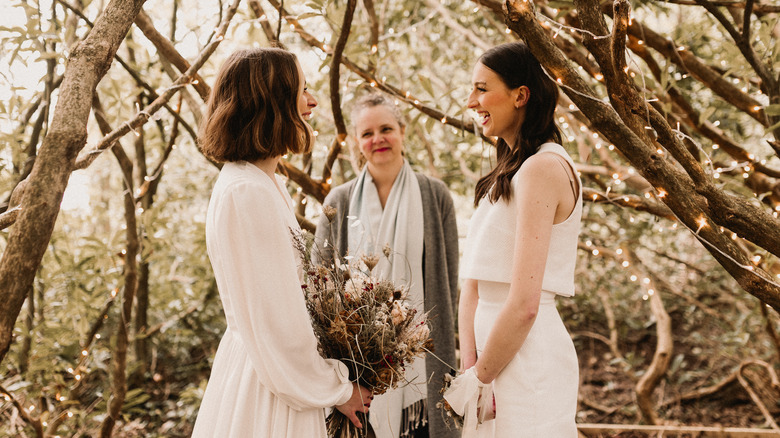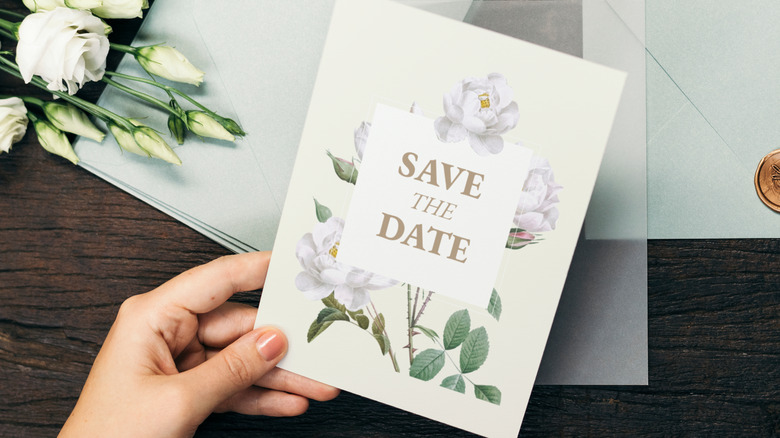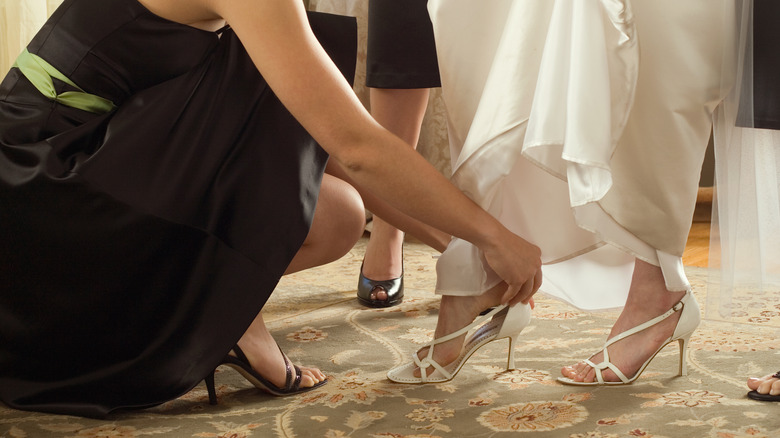Outdated Wedding Trends And Traditions You Should Honestly Just Skip
It goes without saying that your wedding should be totally bespoke for you and your partner. Whether it's a super traditional big day or something a little more unconventional, whatever you choose should represent who you are and your relationship. But, let's be honest, weddings today just aren't the same as they were years ago. In fact, a 2021 Pew Research study found only 6% of Americans are marrying before the age of 21, and only 22% of people have tied the knot by the age of 25. That's around 40% fewer people than in 1980.
"Younger people don't have the resources that they feel they need to get married in terms of deposits for houses, because they've been renting at vast expense. There's a financial disincentive as they see it because they feel they don't have the bedrock," family lawyer Matthew Booth explained to The Telegraph.
But it's not all financial differences. "There are other changes — people wanting to get their careers underway and to feel more economically in place before they commit to a legal relationship," Booth added. Not to mention all the shifts we've seen in women's rights over the years, meaning many women just don't feel the same pressure to marry as they once did. So, with marriage changing so much, it's only natural wedding traditions need to evolve too, right? And then there are those traditions that should just be ditched completely.
Having a traditional wedding cake
We all love a good cake, let's be honest, but the notion of having one on your big day is arguably pretty dated. We live in a world where we've literally mixed a croissant with a donut (the cronut, of course). When you can wander into almost any food store and come out with a totally delicious dessert for a decent price, what's the big deal about the cake?
Plenty of people have passed up the traditional multi-layer treat in favor of something different, and it actually seems to be becoming a bit of a trend to ditch the sweet extravagance. "We are seeing couples create a variety of dessert tables including small dessert bites, pie spreads, donut walls, or even candy stations," wedding venue owner Kate Elder told Reader's Digest.
But even if you ditch the cake, there's no reason you even have to go for a dessert. Sam Jacobson, chef and owner of Philadelphia bakery Stargazy, revealed to Food & Wine that he once made a couple a tiered meat pie instead of a cake. See, you really can have anything you want!
Bridesmaids wearing the same dress in the same color
You may not know it, but there's a very superstitious reason why bridesmaids have all traditionally worn the same dress for a wedding, and it goes way beyond just creating a matching wedding color scheme. "[The tradition is] a holdover from an ancient fear that spirits — or marauders — would come to the wedding and seek out the bride," Thomas P. Farley (who you may know better as Mr. Manners) explained to HuffPost. "At the time, bride and bridesmaids all dressed alike, and the sameness of their outfits was believed to confuse potential evil-doers."
It goes without saying that we know better than that today, which is why we think it's time to leave this tradition in the past where it belongs. These days, we're all much more conscious of what styles and colors of clothing look good on us, and we know no two bodies are the same. That's why it's so important, especially on a day like a wedding day, to make sure everyone is feeling confident and gorgeous on the inside and outside. That may mean giving bridesmaids total free reign over what color and style of dress they wear, embracing the mismatched bridesmaid dress trend (we love the idea of each member of the bridal party wearing a different color like a rainbow). Or you could even opt for a multi-wear dress that each person can adapt into a design that's most flattering for them.
Steering clear of black
We know wearing white is super traditional for a bride, but on the other end of the spectrum, it's arguably just as traditional to avoid wearing black. According to tradition, neither the guests nor the wedding party should be donned in black. This is because, in many cultures, black clothing is not traditionally seen as a happy, celebratory color. "In many instances, especially here in the United States, wearing black to a wedding has been seen as a fashion faux pas because typically the color black is associated with mourning," wedding etiquette expert Elaine Swann explained to Brides.
But times, they are a-changing, and we think it's about time to get rid of the idea black clothing can't be appropriate for a wedding. In fact, as Swann herself admitted, there are many ways to make it look super chic if done right. She suggested wearing something dark with brighter-colored accessories to really make it pop. And it shouldn't only be reserved for wedding guest styles. If you're a bride who likes the idea of a black wedding gown, you go for it!
Giving household items as gifts
It used to be tradition to buy household items for a couple's wedding to set them up to move in together (cohabitating before marriage was largely frowned upon in many circles, remember). But these days, more and more couples are living together before tying the knot, which makes typical presents like toasters, cutlery, or glassware redundant for many. According to a national survey from the University of Denver, which was published by the Institute for Family Studies in 2023, as many as 70% of married couples moved in together before heading down the aisle.
So what should couples get on their wedding day instead of old reliables for the home? According to a 2019 National Wedding Survey conducted by Hitched, the most asked-for gift by betrothed couples in the United Kingdom is either cash or honeymoon vouchers. Thought handing over money as a gift was rude? Clearly not anymore.
The seemingly never-ending receiving line
Of course you want to be able to chat individually with every guest who came out for your big day, but, particularly at larger weddings, the whole concept of a receiving line can be pretty tedious. For those unfamiliar, this tradition involves the bride and groom standing in one place (usually at the door of the reception hall) and having their guests line up to be greeted.
The reason why we're putting this one on the to-go pile is that it's impossible to have a meaningful chat with each and every person via this method — unless you're willing to leave your guests waiting in line for hours at a time. "No one appreciates standing and waiting to say a brief hello when their time is more well spent enjoying your bar, appetizers, and gorgeous surroundings while mingling with other guests," Lori Stephenson, wedding planner and founder of Lola Event Productions, admitted to HuffPost.
So, how can you make sure you're still polite and speak to each guest? We'd recommend making your way around the tables one by one at the reception. Alhough Stephenson had another fun idea: bartending! "Welcome all your guests personally while pouring them a glass of bubbly or a signature cocktail and then disappear for a few minutes to change before you walk down the aisle. Your guests will get a huge kick out of it, have fun saying hello and snapping photos," she suggested.
Handing out wedding favors
Wedding favors – because paying thousands of dollars to entertain, feed, and provide drinks for everyone just wasn't enough, right? With prices for, well, pretty much everything making a steep incline, the idea of paying for your entire wedding and then giving everyone another gift on top of that just seems plain old silly. And it seems like a lot of couples agree with that concept. According to The Knot's 2022 Real Weddings Study, 69% of couples handed out favors on their big day back in 2017, but that number fell to just 48% by 2022.
Plus, though wedding favors are certainly a nice gesture and a great way to commemorate a lovely day, they're probably just going to go to waste. That's because your guests likely won't do anything with them, as they're not always the most practical of pressies. "The spoiler alert is that no, guests do not want them," New York wedding planner Jane Handel confirmed to The Atlantic. So why not save your cash or put it toward something else for your big day?
Having all-female bridesmaids and all-male groomsmen
C'mon, world. In an age where people should be feeling freer than ever to be whoever they want to be, regardless of their sex or gender, why are bridesmaid spots still reserved for those who identify as women, and groomsmen spots for those who identify as men? After all, men can be just as good bridesmaids (or bridesmen) as women, and women can make just as good groomsmen (or groomsmaids) as men.
"It is perfectly acceptable to have either gender as bridesmaids and groomsmen," Kristin Watkins, owner and lead planner at Stephanie Rose Events, confirmed to Reader's Digest. "We have started using the term entourage to describe the wedding party," she added. Etiquette expert Nick Leighton shared a similar take on how things are changing across the wedding landscape with HuffPost. "Scrounging for attendants of the same gender when you have one or more super-close friends of the opposite gender is absurd, and now, gratefully, no longer a societally expected norm," he said.
Likewise, we think the tradition of having the bridesmaids be all the bride's nearest and dearest and the groomsmen being the groom's has to go too. Why not mix it up and have close friends of both the bride and the groom on both sides? It is 2023, after all!
A bride being unable to wear white for her second wedding
It's pretty common knowledge that the reason brides wear white on their wedding day is because it represents the idea of purity, virginity, and innocence. The idea that a bride who is no longer a virgin shouldn't wear white stems from the Bible. Traditionally, sex before marriage was considered a sin in the Christian religion. That then evolved into the idea that upon a second marriage to another partner, the bride shouldn't wear white.
However, it's safe to say times have changed. Attitudes towards sex before marriage and divorce have shifted drastically over the past few decades, and we think a bride should wear white (if she wants to, of course!) no matter how many times she may have walked down the aisle before. After all, according to the National Healthy Marriage Resource Center, as of 2001, more than 10.2 million women in the U.S. had already been married once before tying the knot with their current partner.
"Etiquette rules of the past said that these brides could not wear white, but today plenty of my encore brides are ignoring this antiquated rule and donning beautiful white gowns," wedding planner Lauren Chitwood told Martha Stewart Weddings. And we couldn't support the idea more.
Seating all the bride's guests on one side of the aisle and all the groom's on the other
You're officially joining your life together with someone else's, so why keep all your guests divided during the wedding ceremony? This tradition of each person picking a side is particularly prevalent in religious ceremonies, such as Christian services, where the bride's guests are invited to sit on the left side as you look down the aisle. In Jewish culture, the bride's guests traditionally sit on the right side. But the whole "one side for you and one side for me" thing has long been the standard even in non-religious ceremonies. It's rumored that the tradition started decades ago and grew from the concept of men and women having to sit on separate sides of the aisle.
While it's certainly nice to look at a specific side of the room and see all your closest friends and family staring back at you, this is one tradition we think could go by the wayside. Why? Well, this is a great opportunity to represent the idea of blending two lives, two families, and two sets of friends. Having everyone sit together is a great way to symbolize the idea that "What's mine is yours." Plus, there's a good chance people on either side of the divide will already know each other, and by letting them mingle, it's a great recipe for new friendships ... or even romances.
The role of the father of the bride
Starting from engagement, it's traditional for the father of the bride to approve of the marriage and then agree to give away his daughter to another man. But we're not really feeling that concept. It's no doubt a touching gesture for someone to ask their partner's father if they approve of the idea of them proposing, but it's important to remember that grown women make their own decisions on who they want to marry. They don't need their father's permission.
Similarly, the father of the bride's role in passing his daughter along is a tradition that can be pretty alienating for those who do not have a father in their lives — and it leaves out the mother of the bride, who's left to look on. There are a number of ways you can tweak this tradition to make it more unique and modern.
"Some brides choose to have both her mother and father walk her down the aisle together," Deborah L. Erb, owner and event planner for Simply Events Inc., told Martha Stewart Weddings. "A bride who lost her father, or whose father is no longer in her life, may choose to have her brother, uncle, grandfather, or mom walk her down the aisle." And, of course, there's always the possibility of having a close friend or relative who doesn't identify as male walk you down the aisle. Or just sashay down it yourself.
The bride or mother of the bride not making a speech
For many traditional, heterosexual Western weddings, there's an order for the speeches. Usually, the speeches will begin with the father of the bride, followed by the groom, then the best man. "In same-sex weddings, it is also common for both partners to speak but sometimes only one does," writer Marc Blakewill explained to Hitched.
After that, there's time for any other speeches to be made by people not in the traditional order, but those extras rarely include words from the bride or the mother of the bride. It goes without saying that tradition has dictated that it's the men in the wedding we have to hear from, while the women stay quiet.
But no longer! At least if we have our say. We want to say goodbye to this tradition, with more brides (and mothers of brides) standing up to make speeches at their own weddings, alongside the groom and the father of the bride. And why stop there? We'd also love to see it become more commonplace for the maid of honor or bridesmaids to speak up, as well as sisters, aunties, friends, and anyone else who would like to spread the love.
Using traditional wedding vows
Have you ever actually sat down and read the traditional vows that used to be said during a wedding ceremony? Because, yeesh. "In the 'Book of Common Prayer,' published in 1549, during Medieval England, it was customary for women to say in their vows, 'to love, cherish and to obey, until death do us part,'" Amanda Miller, an associate professor of sociology at the University of Indianapolis, told The New York Times. Yet, the groom didn't have to use the word "obey" when he spoke his vows. The traditional vows lingered for a long time into the more modern day, and some couples still choose to say this version.
For us, though, this imbalance is a tradition that needs to be broken. In heterosexual or same-sex relationships, to take out the power imbalance, those choosing to recite these traditional vows should both say the exact same words, whether the vows contain the word "obey" or not. Equally, we love the idea of couples writing their own vows for their ceremony instead of relying on standard ones that are outdated and rife with misogyny.
Sending out physical save-the-date cards and invitations
Physical save-the-date cards and wedding invitations can be gorgeous, but, boy, are they expensive. Before we had access to the internet, one of the few ways to let people know about your wedding day was to physically send them a card or give them a call. But we're all so easy to get in touch with these days, we no longer have to go down that route. And there are many benefits to sending an e-card or instant message, too.
It's no longer considered taboo to forego physical copies. In fact, we're relying on messaging platforms to get in touch with people more than ever. Instead of spending hundreds of dollars (or potentially even more) on wedding stationery that will only end up in the recycling bin, it might be time to put this tradition to bed.
Instead, we'd suggest sending out personal messages or a group message online letting your closest friends and family know the details of your big day. After all, it's then easy for them to add it to their phone calendar anyway, so why not save them that task and save yourself a solid few bucks? Plus, you'll probably find yourself right on trend if you do. "Electronic save-the-dates and invitations will continue to be popular for 2022 as couples focus their budget on the wedding-day experience and being conscious about waste," Lovely Day Events owner and wedding planner Lindsey Nickel told Insider.
The bride wearing heels
We can't lie, we do adore a good pair of heels. The thing we don't love, though? The pain that comes with them. It's a pretty widespread trend, and has been for a while now, for bridal shoes to be a glitzy white high heel — but we think it's time to skip the painful footwear. After all, how in the world are you supposed to enjoy one of the best days of your life if all you can think about is how much your feet are throbbing? For brides who opt for a traditional long dress, no one can even see what's underneath!
If you do decide to opt for something a little more comfortable with your bridal outfit, then you'll be in good company. "More and more brides are opting for comfort first when it comes to their wedding shoes to ensure they can dance through the night without having to worry about ripping their dress or being in pain all night long," Anny Choi, head stylist for wedding website Over the Moon, told Who What Wear. There are so very, very many different shoe designers out there today too, so you're bound to find something stunning and comfortable at the same time.
